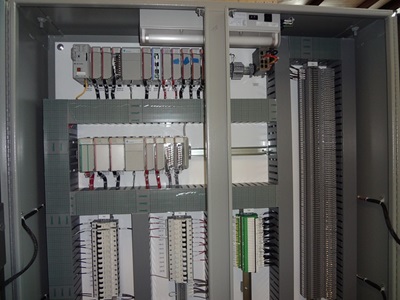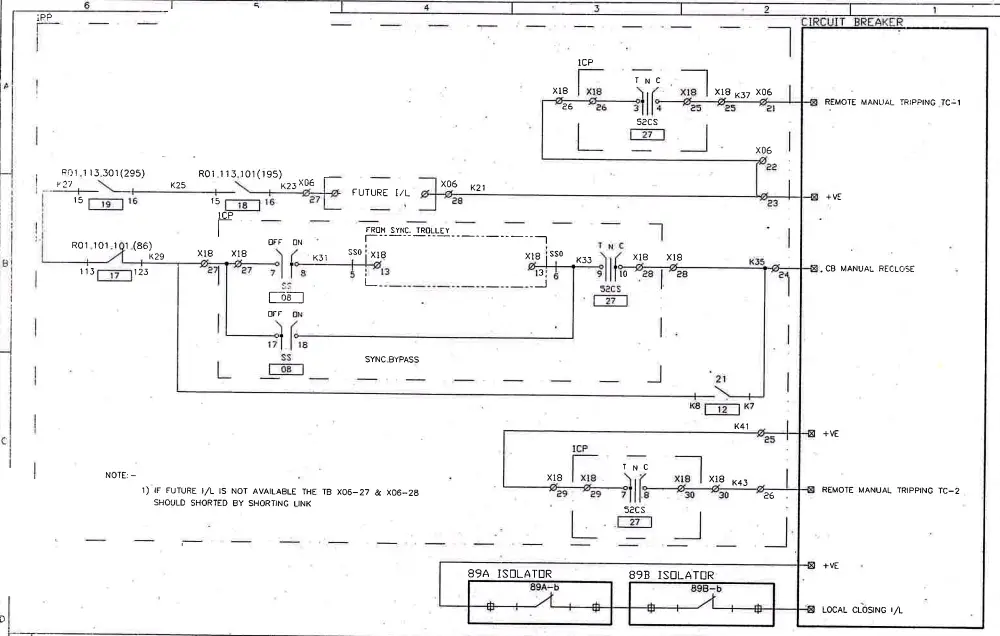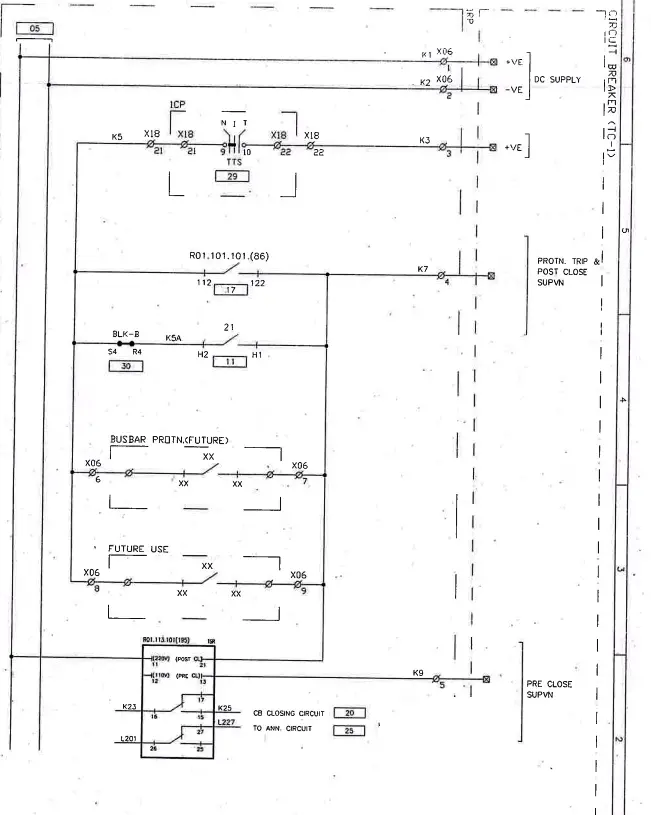
Electrical drawing of Tripping circuit implies the wiring diagram which is designed in a way that it will trip the circuit breaker either on some fault or manually through trip and close switch (TNC Switch). Different relays are used for protection and they are housed in control and relay panel and purpose of these relays is to sense the fault and extend tripping command to trip coil of the circuit breaker. Circuit breaker are also made off manually through trip and close(TNC) switch as per the requirement.
Electrical drawing of Tripping circuit on Manual operation :
We have explained meaning of wire tags (ferrules) , different electric symbols and terminal blocks here. Now let us try to understand the drawing below which is of manual tripping circuit i.e tripping of circuit breaker from Trip and close switch (TNC switch):
Circuit breaker has been represented in the drawing below as separate solid rectangular box and the dotted box is of control and relay panel (CRP). As explained earlier in closing circuit diagram ,+Ve supply in the control panel for both tripping and closing circuit is taken from circuit breaker itself. Please note that there are two tripping coils in this circuit breaker and they are named TC-01 and TC-02. Two coils are given for extra safety as coils sometimes get defective and tripping of breaker is necessary for clearing the fault.

+Ve supply (+110v for 220v DC system) for Tripping (as well as closing circuit) in the panel is taken from C.B . In the drawing above for TC-01, Dc +Ve enters the Panel at Terminal block no X06-23 (Name of T.B is X06 and position is 23).Then it connects to T.B X06-22 and then to T.B X1B-26 and from this T.B wire further connects to position no-03 of input side of TNC switch.
Now that we have +Ve voltage at TNC switch ,when we will move the switch towards trip position it will extend +Ve voltage to trip coil of breaker from TB X06-21 and then TC-01 will operate and breaker will trip. Trip coil and closing coil is always given -Ve Voltage and +Ve is extended through TNC switch or through protection relays.
Similarly for TC-02,Ve supply is taken from C.B and it enters the Panel at Terminal block no X06-25 and ferrule is K41.Then it connects to T.B X18-29 and then from this T.B wire further connects to input side of TNC switch at position no-07 of TNC switch. Now that we have +Ve voltage at TNC switch ,when we will move the switch towards trip position it will extend +Ve voltage to trip coil of breaker from TB X06-26 and then TC-02 will operate and breaker will trip.
Circuit drawing of Tripping of circuit breaker on fault :
In the diagram below Relay21 is Distance protection relay and Relay R01.101.101 is Master trip relay also called 86 relay. Both of them have been connected in parallel in the diagram. Please see below that contact of Distance relay (H2 and H1) and 86 relay (112 and 122) will remain normally open (NO contact), but as soon as the fault is sensed the contacts of relay closes and it extends +Ve voltage through TBNO X06-04 and wire ferrule K7 to trip coil of breaker and the breaker trips.

Master trip relay (Relay 86) is not a fault sensing relay ,it is an auxiliary relay and it is coupled with other relays (overcurrent earth fault relay, distance relay, frequency relay etc ) and when these fault sensing relays sense the fault ,they send +Ve signal to 86 relay which trips and then extend +Ve Dc voltage to tripping coil of breaker which trips the breaker.
You may watch this for more info:
FAQs:
- What is the purpose of the tripping circuit in a circuit breaker?
- This circuit purpose is to detect faults or abnormal current conditions and then it activates the mechanism that opens the circuit breaker which interrupts the current flow . It is a very important safety feature.
- This circuit purpose is to detect faults or abnormal current conditions and then it activates the mechanism that opens the circuit breaker which interrupts the current flow . It is a very important safety feature.
- How does a tripping circuit work?
- A tripping circuit consists of protective relays which monitors parameters such as overcurrent, short-circuit conditions, voltage levels, or other abnormal electrical events. When a fault is sensed by the protective relays , the relay operates and sends tripping command to the trip coil or solenoid, which in turn releases the mechanical mechanism of breaker to open the circuit breaker contacts (poles).
- A tripping circuit consists of protective relays which monitors parameters such as overcurrent, short-circuit conditions, voltage levels, or other abnormal electrical events. When a fault is sensed by the protective relays , the relay operates and sends tripping command to the trip coil or solenoid, which in turn releases the mechanical mechanism of breaker to open the circuit breaker contacts (poles).
- Can a circuit breaker be manually tripped?
- Yes, all circuit breakers can be tripped manually , they have a manual trip push button or a lever that allows to open the contacts manually. This manual operation is often used for maintenance or testing purposes.
- Yes, all circuit breakers can be tripped manually , they have a manual trip push button or a lever that allows to open the contacts manually. This manual operation is often used for maintenance or testing purposes.
- What is a ground fault tripping circuit?
- A ground fault tripping circuit is a basically earth fault sensing mechanism . When a earth fault is detected, the circuit breaker is tripped to prevent electrical shock hazards and protect equipment.
- A ground fault tripping circuit is a basically earth fault sensing mechanism . When a earth fault is detected, the circuit breaker is tripped to prevent electrical shock hazards and protect equipment.
- How do you test the tripping circuit of a circuit breaker?
- Testing typically involves using a calibrated test set to simulate various fault conditions to ensure that the tripping circuit operates as expected without opening under normal operating conditions.
- Testing typically involves using a calibrated test set to simulate various fault conditions to ensure that the tripping circuit operates as expected without opening under normal operating conditions.
- What is a shunt trip in a circuit breaker?
- A shunt trip is an additional feature in some circuit breakers that allows for remote tripping of the breaker through an external signal or control voltage. It is often used for safety and control purposes.
- A shunt trip is an additional feature in some circuit breakers that allows for remote tripping of the breaker through an external signal or control voltage. It is often used for safety and control purposes.
- Can a tripping circuit fail or malfunction?
- Yes, like any electrical component, tripping circuits can fail or malfunction due to issues such as wear and tear, manufacturing defects, or improper maintenance. Regular testing and inspection are essential to ensure their reliability.
- Yes, like any electrical component, tripping circuits can fail or malfunction due to issues such as wear and tear, manufacturing defects, or improper maintenance. Regular testing and inspection are essential to ensure their reliability.
- What is the difference between instantaneous and time-delay tripping?
- Instantaneous tripping occurs when the current exceeds a certain preset level, causing the circuit breaker to trip immediately. Time-delay tripping has an adjustable delay, allowing the circuit to withstand brief overcurrent conditions without tripping.
- Instantaneous tripping occurs when the current exceeds a certain preset level, causing the circuit breaker to trip immediately. Time-delay tripping has an adjustable delay, allowing the circuit to withstand brief overcurrent conditions without tripping.
- Can a circuit breaker be reset after it has tripped?
- Yes, most circuit breakers have a reset mechanism. After the fault or issue that caused the trip is resolved, the circuit breaker can be manually reset by turning it to the “off” position and then back to the “on” position.
- Yes, most circuit breakers have a reset mechanism. After the fault or issue that caused the trip is resolved, the circuit breaker can be manually reset by turning it to the “off” position and then back to the “on” position.
- What safety precautions should be taken when working with circuit breakers and their tripping circuits?
- Always follow appropriate safety procedures when working with electrical equipment. This includes de-energizing the circuit, wearing appropriate personal protective equipment, and ensuring only qualified personnel perform maintenance, testing, and repairs.